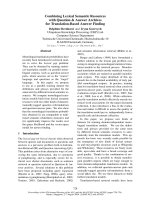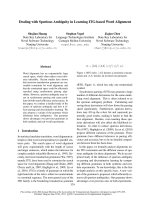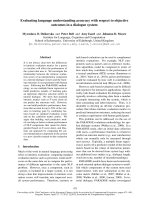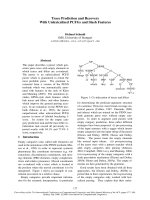Depth recovery with rectification using single lens prism based stereovision system
Bạn đang xem bản rút gọn của tài liệu. Xem và tải ngay bản đầy đủ của tài liệu tại đây (2.19 MB, 211 trang )
DEPTH RECOVERY WITH RECTIFICATION
USING SINGLE-LENS PRISM BASED
STEREOVISION SYSTEM
WANG DAOLEI
NATIONAL UNIVERSITY OF SINGAPORE
2012
DEPTH RECOVERY WITH RECTIFICATION
USING SINGLE-LENS PRISM BASED
STEREOVISION SYSTEM
WANG DAOLEI
(B.S., ZHEJIANG SCI-TECH UNIVERSITY)
A THESIS SUBMITTED
FOR THE DEGREE OF DOCTOR OF PHILOSOPHY
DEPARTMENT OF MECHANICAL ENGINEERING
NATIONAL UNIVERSITY OF SINGAPORE
2012
Declaration I
National University of Singapore NUS
DECLARATION
I hereby declare that the thesis is my original work and it has been written by me in its
entirety.
I have duly acknowledged all the sources of information which have been used in the
thesis.
This thesis has also not been submitted for any degree in any university previously.
Wang Daolei
16 August, 2012
Acknowledgments II
National University of Singapore NUS
ACKNOWLEDGMENTS
I wish to express my gratitude and appreciation to my supervisor, A/Prof. Kah Bin LIM for
his instructive guidance and constant personal encouragement during every stage of my Ph.D.
study. I gratefully acknowledge the financial support provided by the National University of
Singapore (NUS) and China Scholarship Council (CSC) that make it possible for me to finish
this study.
I appreciate Dr. Xiao Yong, for his excellent early contribution initiation on single-lens
stereovision using a bi-prism (2F-filter).
My gratitude also goes to Mr. Yee, Mrs. Ooi, Ms. Tshin, and Miss Hamidah for their help on
facility support in the laboratory so that my research could be completed smoothly.
It is also a true pleasure for me to meet many nice and wise colleagues in the Control and
Mechatronics Laboratory, who made the past four years exciting and the experience
worthwhile. I am sincerely grateful for the friendship and companionship from Zhang Meijun,
Wang Qing, Wu Jiayun, Kee Wei Loon, and Bai Yading, etc.
Finally, I would like to thank my parents, and sisters for their constant love and endless
support through my student life. My gratefulness and appreciation cannot be expressed in
words.
Table of contents III
National University of Singapore NUS
TABLE OF CONTENTS
DECLARATION I
ACKNOWLEDGMENTS II
TABLE OF CONTENTS III
SUMMARY VI
LIST OF TABLES VIII
LIST OF FIGURES IX
LIST OF ABBREVIATIONS XIII
Chapter 1 Introduction 1
1.1 Background 1
1.2 Problem descriptions 2
1.3 Motivation 5
1.4 Scope of study and objectives 6
1.5 Outline of the thesis 7
Chapter 2 Literature review 9
2.1 Stereovision systems 9
2.2 Camera calibration 14
2.3 Epipolar geometry constraints 15
2.4 Review of rectification algorithms 18
2.5 Stereo correspondence algorithms 20
2.6 Stereo 3-D reconstruction 31
2.7 Summary 32
Chapter 3 Rectification of single-lens binocular stereovision system 33
3.1 The background of stereo vision rectification 35
3.2 Rectification of single-lens binocular stereovision system using geometrical
approach 40
3.2.1 Comp 41
Table of contents IV
National University of Singapore NUS
3.2.2 Rectification Algorithm 55
3.3 Experimental results and discussion 57
3.4 Summary 65
Chapter 4 Rectification of single-lens trinocular and multi-ocular stereovision system
66
4.1 A geometry-based approach for three-view image rectification 66
4.1.1 Generation of three virtual cameras 67
analysis of ray sketching 69
4.1.3 Rectification Algorithm 84
4.2 The multi-ocular stereo vision rectification 85
4.3 Experimental results and discussion 89
4.4 Summary 96
Chapter 5 Segment-based stereo matching using cooperative optimization: image
segmentation and initial disparity map acquisition 98
5.1 Image segmentation 99
5.1.1 Mean-shift method 100
5.1.2 Application of mean-shift method 102
5.2 Initial disparity map acquisition 104
5.2.1 Biologically inspired aggregation 104
5.2.2 Initial disparity map estimation algorithm 106
5.3 Experimental results and discussion 109
5.3.1 Experimental procedure 110
5.3.2 Experimentation results 110
5.3.3 Analysis of results 112
5.4 Summary 113
Chapter 6 Segment-based stereo matching using cooperative optimization: disparity
plane estimation and cooperative optimization for energy function 115
6.1 Disparity plane estimation 115
6.1.1 Plane fitting 116
6.1.2 Outlier filtering 118
6.1.3 Merging of neighboring disparity planes 122
Table of contents V
National University of Singapore NUS
6.1.4 Experiment 126
6.2 Cooperative optimization of energy function 128
6.2.1 Cooperative optimization algorithm 128
6.2.2 The formulation of energy function 130
6.2.3 Experiment 132
6.3 Summary 137
Chapter 7 Multi-view stereo matching and depth recovery 138
7.1 Multiple views stereo matching 138
7.1.1 Applying the local method to obtain multi-view stereo disparity 140
7.1.2 Applying the global method to obtain multi-view disparity map 142
7.2 Depth recovery 149
7.2.1 Triangulation to general stereo pairs 149
7.2.3 Triangulation to rectified stereo pairs 150
7.3 Experimental results 153
7.3.1 Multi-view stereo matching algorithm results and discussion 153
7.3.2 Depth recovery results and discussion 157
7.4 Summary 162
Chapter 8 Conclusions and future works 163
8.1 Summary and contributions of the thesis 163
8.2 Limitations and Future works 166
Bibliography 168
Appendices 180
List of publications 194
Summary VI
National University of Singapore NUS
SUMMARY
This thesis aims to study the depth recovery of a 3D scene using a single-lens stereovision
system with prism (filter). An image captured by this system (image acquisition) is split into
multiple different sub-images on the camera image plane. They are assumed to have been
captured simultaneously by a group of virtual cameras which are generated by the prism. A
point in the scene would appear in different locations in each of the image planes, and the
differences in positions between them are called the disparities. The depth information of the
point can then be recovered (reconstruction) by using the system setup parameters and the
disparities. In this thesis, to facilitate the determination of the disparities, rectification of the
geometry of virtual cameras is developed and implemented.
A geometry-based approach has been proposed to solve stereo vision rectification issue of the
stereovision in this work which involves virtual cameras. The projection transformation
matrices of a group of virtual cameras are computed by a unique geometrical ray sketching
approach, with which the extrinsic parameters can be obtained accurately. This approach
eliminates the usual complicated calibration process. Comparing the results of the geometry-
based approach to the results of camera calibration technique, the former approach produces
better results. This approach has also been generalized to a single-lens based multi-ocular
stereovision system.
Next, an algorithm of segment-based stereo matching using cooperative optimization to
extract the disparities information from stereo image pairs is proposed. This method combines
the local method and the global method, which utilizes the favourable characters of the two
methods such their computational efficiency and accuracy. In addition, the algorithm for
multi-view stereo matching has been developed, which is generalized from the two views
Summary VII
National University of Singapore NUS
stereo matching approach. The experimental results demonstrate that our approach is effective
in this endeavour.
Finally, a triangulation algorithm was employed to recover the 3D depth of a scene. Note that
the 3D depth can also be recovered from disparities as mentioned above. Therefore, this
algorithm based on triangulation can also be used to verify the overall correctness of the
stereo vision rectification and stereo matching algorithm.
To summarize, the main contribution of this thesis is the development of a novel stereo vision
technique. The presented single lens prism based multi-ocular stereovision system may widen
the applications of stereovision system; such as close-range 3D information recovery, indoor
robot navigation / object detection, endoscopic 3-D scene reconstruction, etc.
List of tables VIII
National University of Singapore NUS
LIST OF TABLES
Table 2.1 Block matching methods 23
Table 2.2 Summary of 3-D reconstruction three cases [10] 31
Table 3.1 The parameters of single-lens stereovision using biprism 46
Table 3.2 The values of parameters for bi-prism used in the experiment 58
Table 3.3 The descriptions of the columns in Table 3.4 64
Table 3.4 Results of conventional calibration method and geometrical method for obtaining
stereo correspondence 65
Table 4.1 The parameters of tri-prism used in our setup 73
Table 4.2 The descriptions of the columns in Table 4.3 93
Table 4.3 The result of comparing calibration method and geometry method for obtaining
stereo correspondence 94
Table 5.1 Percentages of bad matching pixels of reference images by five methods 113
Table 6.1 Percentages of bad matching pixels of disparity map obtained by the two methods
compare with ground-truth 128
Table 6.2 Middlebury stereo evaluations on different algorithms, ordered according to their
overall performance 136
Table 7.1 The results of two-view and multi-view stereo matching algorithm 155
Table 7.2 Recovered depth using binocular stereovision 161
List of figures IX
National University of Singapore NUS
LIST OF FIGURES
Figure 1.1 A perfectly undistorted, aligned stereo rig and known correspondence 3
Figure 1.2 Depth varies inversely to disparity 4
Figure 1.3 Description of the overall stereo vision technique of our thesis 6
Figure 2.1 Conventional stereovision system using two cameras 10
Figure 2.2 Modeling of two camera canonical stereovision system 11
Figure 2.3 A single-lens stereovision system using a glass plate 12
Figure 2.4 A single-lens stereovision system using three mirrors 12
Figure 2.5 Symmetric points from symmetric cameras 13
Figure 2.6 A single-lens stereovision system using two mirrors 13
Figure 2.7 The epipolar geometry 16
Figure 2.8 The geometry of converging stereo with the epipolar line (solid) and the collinear
scan-lines (dashed) after rectification 18
Figure 2.9 (a) disparity-space image using left-right axes and; (b) another using left-disparity
axes 26
Figure 3.1 Single-lens based stereovision system using bi-prism 33
Figure 3.2 Single-lens stereovision using optical devices 34
Figure 3.3 Pinhole camera model 35
Figure 3.4 Epipolar geometry of two views 37
Figure 3.5 Rectified cameras. Image planes are coplanar and parallel to baseline 38
Figure 3.6 Geometry of single-lens bi-prism based stereovision system (3D) 44
Figure 3.7 Geometry of left virtual camera using bi-prism (top view) 45
Figure 3.8 The relationship of direction vector of AB and normal vector of plane
49
Figure 3.9 The relationship of direction vector of AB and normal vector of plane
51
Figure 3.10 Rectification of virtual image planes 56
List of figures X
National University of Singapore NUS
Figure 3.11
60
Figure 3.12
soap bottle image pair (a) and rectified pair (b) 61
Figure 3.13
cif 62
Figure 3.14
63
Figure 4.1 Single-lens based stereovision system using tri-prism 67
Figure 4.2 Single-lens stereovision system using 3F filter 68
Figure 4.3 The structure of tri-prism 70
Figure 4.4 Geometry of left virtual camera using tri-prism 71
Figure 4.5 The workflow of determining the extrinsic parameters of virtual camera via
geometrical analysis 72
Figure 4.6 Relationship of direction vector line PM 76
Figure 4.7 Illustration of direction vector of line MN 78
F
about -axis 80
Figure 4.9 The relationship of -axis and -axis 81
Figure 4.10 The image plane
rotates to image plane
about -axis 82
Figure 4.11 Geometry of single-lens based on stereovision system using 4-face prism 86
Figure 4.12 Geometry of the single-lens stereovision system using 5-face prism 89
Figure 4.13 The image captured from trinocular stereovision and rectified images (robot) 91
Figure 4.14 The image captured from trinocular stereovision and rectified images 92
Figure 4.15 The images capture from four- 95
Figure 4.16 The images capture from four-
images) 96
Figure 5.1 The flow chart of obtaining depth map from stereo matching algorithm 99
Figure 5.2 Segmented by mean-shift method 103
Figure 5.3 Segmented by mean-shift method (using standard image) 103
110
Figure 5.5 Initial disparity maps by five methods (SAD, SSD, NCC, SHD, our method) 111
List of figures XI
National University of Singapore NUS
Figure 6.1 The flow chart of the estimated disparity plane parameters 121
Figure 6.2 Two type properties of plane 124
Figure 6.3 The flow chart for the procedure of merging the neighboring disparity plane 126
Figure 6.4 The results of disparity map obtained in each stage 127
Figure 6.5 Segments after implementation of mean-shift method 129
Figure 6.6 Final results of the disparity maps obtained by our algorithm (cooperative
optimization) 133
ge, which are extracted
from rectified image in square, and (c) disparity map 134
rectified image in square, and (c) disparity map 135
135
Figure 7.1 Collinear multiple stereo 139
Figure 7.2 The multi-view stereo pairs 143
Figure 7.3 Stereo images system 150
Figure 7.4 Triangulation with nonintersecting 150
Figure 7.5 Rectified cameras image planes 152
Figure 7.6 Tsukuba images: (a), (b), and (c) are Tsukuba images, (d) ground-truth map, (e)
multi-view stereo matching algorithm result (local method), (f) multi-view stereo
matching algorithm result (global method) 154
Figure 7.7 The 156
156
) the disparity map, and (c)
depth reconstruction 157
(c) depth recovery 158
and (c) depth recovery 159
160
List of figures XII
National University of Singapore NUS
Figure 7.13 Several test points are selected in robot image 161
List of abbreviation XIII
National University of Singapore NUS
LIST OF ABBREVIATIONS
3D/3-D Three-dimension
2D/2-D Two-dimension
CGI Computer Generated Imagery
CCD Charge-Coupled Devices
PPM Perspective Projection Matrix
CCS Camera Coordinate System
WCS World Coordinate System
SVD Singular Value Decomposition
HVS Human Visual System
AD Absolute intensity Differences
DSI Disparity Space Image
SAD Sum of Absolute Differences
ZSAD Zero-mean Sum of Absolute Differences
LSAD Locally scaled Sum of Absolute Differences
SSD Sum of Squared Differences
SSSD Sum of sums of absolute differences
ZSSD Zero-mean Sum of Squared Differences
LSSD Locally scaled Sum of Squared Differences
NCC Normalized Cross Correlation
ZNCC Zero-mean Normalized Cross Correlation
SHD Sum of Hamming Distances
WTA Winner-take-all
DP Dynamic Programming
GC Graph Cuts
List of abbreviation XIV
National University of Singapore NUS
CA Cooperative Algorithms
NN Neural Network algorithm
BP Belief Propagation
BPASW Biologically and Psychophysically inspired Adaptive Support
Weights
List of symbols XV
National University of Singapore NUS
LIST OF SYMBOLS
Baseline, i.e. the distance between the two camera optical centres:
The disparity of the corresponding points between the left and right image:
The center of left image plane:
The center of right image plane:
The depth of object in world coordinate system:
Effective real camera focal length:
Rotation matrix:
Translation vector:
The object point in world coordinate frame:
The point on the left image plane:
The point on the right image plane:
The optical center of camera:
World coordinate system:
Camera coordinate system:
Perspective projection matrix:
The intrinsic parameters:
The extrinsic parameters:
The fundamental matrix:
The epipole of left image:
The epipole of right image:
The corner angle of the bi-prism:
The refractive index of the prism glass material:
The focal length of the virtual cameras:
Chapter 1 Introduction 1
National University of Singapore NUS
Chapter 1 Introduction
1.1 Background
In computer vision, stereovision is a popular research topic due to new demands in various
applications, notably, in security and defense. Stereovision is the extraction of 3D information
from two or multiple digital images of a same scene captured by more than one CCD camera.
Human beings have the ability to perceive depth easily through the stereoscopic fusion of a
pair of images registered from the eyes. Therefore, we are able to perceive the three-
dimensional structure/information of objects in a scene. Although the human visual system is
still not fully understood, stereovision technique which models the way humans perceive
range information has been developed to enable and enhance the extraction of 3D depth
information. Stereovision is now widely used in areas such as automatic inspection, medical
imaging, automotive safety, surveillance, and other applications. References [1-7] give a list
of existing applications.
Over the years, the foundation of 3D vision has been developed continuously. According to
Form an image (or a series of images) of
a scene, derive an accurate three-dimensional geometric description of the scene and
quantitatively determine the properties of the objects in the scene
formation consists of three steps: Data Capturing, Reconstruction and Interpretation. Barnard
and Fischler [9] have proposed a different list of steps for the formation of 3D stereovision
which include camera calibration, stereo correspondence, and reconstruction. For each of
these steps, many methods have been developed. However, the search for effective and simple
methods for each of the steps is still an active research area.
Chapter 1 Introduction 2
National University of Singapore NUS
This thesis aims to study the reconstruction of a 3-dimensional scene, or also known as depth
recovery, using a single-lens stereovision system using prism [21]. The present work reported
in this thesis includes the development of the stereo rectification, stereo correspondence and
3-D scene reconstruction algorithms. This introductory chapter is divided into five sections.
Section 1.1 provides the background of stereovision. Section 1.2 presents the problem
descriptions, while the next section, Section 1.3 presents our motivation. Section 1.4 describes
the scope of study and objectives of this research. The final section, Section 1.5, gives the
outline of the entire thesis.
1.2 Problem descriptions
Stereo vision refers to the ability to infer information on the 3-D structure and distance of a
scene from two or more images [10]. From a computational standpoint, a stereovision system
must solve two problems. The first one is known as stereo correspondence, which consists of
determining the corresponding points of the image points in one image (the left image, say) in
the other mage (right image in this case). The purpose of this process is really to determine
the disparity between the two corresponding points which will be discussed in detail below. In
addition, due to the occlusion problem, some parts of the scene are not visible in one of the
images. Therefore, a stereovision system must also be able to determine which parts of the
image at which the search of the corresponding points are not possible.
The second aspect of a stereovision system is to recover the depth of a scene/object, which is
called reconstruction, or depth recovery. Our vivid perception of the 3-D world is due to the
interpretation in the brain which gives the computed difference in retinal position, named as
disparity, between the corresponding features of objects in a scene. The disparities of all the
image points form the so-called disparity map which can be displayed as an image. If the
Chapter 1 Introduction 3
National University of Singapore NUS
geometry of the stereovision system is known, the disparity map can be converted into a 3-D
map (reconstruction). [10]
The two aforesaid problems of stereovision, stereo correspondence and reconstruction have
been studied by many researchers [35, 63-74]. Figure 1.1 shows a parallel stereovision system.
and
are the centre points of the left and right image planes,
and
are the optical
centers of left and right cameras,
and
are the coordinates of image points in left and
right image plane, is the focal length and is the baseline of the two cameras.
Figure 1.1 A perfectly undistorted, aligned stereo rig and known correspondence
The depth, , can be recovered from the geometry of the system as follows:
Eq. (1.2) expresses the relationship of the depth with
.
Here, we let
-
Chapter 1 Introduction 4
National University of Singapore NUS
where denotes the disparity between the corresponding points between the left and right
image.
We can also conclude from Eq. (1.2) that the depth is inversely proportional to the disparity.
Thus, there is a nonlinear relationship between these two terms (see Figure 1.2).
Figure 1.2 Depth varies inversely to disparity
To sum up, the stereovision work reported in this thesis will consist of the following areas:
(1) Stereo rectification (Chapter 3 and 4)
(2) Stereo correspondence (Chapter 5, 6 and 7)
(3) Depth recovery (Chapter 7)
Chapter 1 Introduction 5
National University of Singapore NUS
However, we have made the assumption that the captured images are free of distortion. We
will follow these three steps in solving the stereo problems depth recovery. The next section
will present the motivation of our work reported in this thesis.
1.3 Motivation
The projection of light rays onto the retina of our eyes will produce a pair of images which are
inherently two dimensional. However, based on this image pair, we are able to interact with
the 3-D surrounding in which we are in. This ability implies that one of the functions of the
human visual system is to reconstruct the 3-D structure of the world from a 2-D image pair.
We shall develop algorithms to re-produce this ability using stereovision system. In our works,
the said desired motivation consists of the three important aspects, stereo rectification, stereo
correspondence, and depth recovery.
The complexity of the correspondence problem depends on the complexity of the scene.
There are constraints (epipolar constraint [10], order constraint) and schemes that can help in
reducing the number of false matches but there are still many unsolved problems in stereo
correspondence. Some of these problems are:
(1) Occlusion which may result in the failure on the searching of corresponding points.
(2) Regularity and repetitive patterns in the scene may cause ambiguity in correspondence.
Finally, note that the accuracy of the 3D depth recovery or reconstruction depends heavily on
the results of the stereo vision rectification and stereo correspondence.
Chapter 1 Introduction 6
National University of Singapore NUS
1.4 Scope of study and objectives
The basis for stereovision is a single three-dimensional physical scene which is projected to a
unique pair of images in two or multiple cameras. The first step of stereovis ion technique is
image acquisition which usually employs two or more cameras to capture different views of a
scene. When a point in the scene is projected into different locations on each image plane,
there will be a difference in the position of its projections, which is called disparity. The
depth recovery or 3D reconstruction of the point can be done by using the properties of the
individual cameras, the geometric relationships between the cameras and the disparity. Figure
1.3 shows the overall stereovision setup and steps in this thesis. The works reported in this
thesis, consisting of the steps shown in Figure 1.3, will follow closely the flow chart shown.
Rectification
calibration
Stereo matching
(Correspondence)
Triangulation
Image 1
Image n
Disparity
map
3D Data
Camera 1
Camera n
Figure 1.3 Description of the overall stereo vision technique of this thesis
The main objective of this work is to develop efficient methods in solving stereovision
problem. More specifically, algorithms and strategies will be designed and implemented to
recover 3-D depth of a given scene using a stereovision setup. The followings steps, each of
which pertains to a specific problem, will be dealt with. The cohesive whole formed by the
solutions of the problems presented in the steps would represent the objective of this thesis.
Chapter 1 Introduction 7
National University of Singapore NUS
(1) Investigate the basis of a single-lens prism based stereovision system developed by Lim
and Xiao [21]. Knowledge gained here would be the use of this novel system and its use in
calibrating the system to determine the intrinsic and extrinsic parameters.
(2) Explore a geometry-based method to rectify the image pairs captured by the single-lens
based stereovision system.
(3) Develop a stereo correspondence algorithm for the image pairs, by combining local and
global methods to solve the correspondence problem. In addition, this algorithm is extended
to solve the multi-view stereo correspondence problem.
The results obtained from this study form a theoretical foundation for the development of a
compact 3D stereovision system. Moreover, this research may contribute to a better
understanding of the mechanism of the stereovision system as the nature of our method is to
analyze the light ray sketching of the cameras. The next section will present the outline of
this thesis.
1.5 Outline of the thesis
In this thesis, the algorithms involved in stereovision are studied and developed to recover the
depth of a scene in 3-dimensions. The outline of the entire thesis is as follows:
Chapter 2 presents the literature review about stereovision which includes stereovision
systems, camera calibration, epipolar geometry constraints, rectification algorithm, stereo
correspondence algorithms and depth reconstruction.
Chapter 3 describes and discusses stereo vision rectification based on single-lens binocular
stereo vision. A geometry-based approach is proposed to determine the extrinsic parameters
of the virtual cameras with respect to the real camera. The parallelogram and refraction rules
Chapter 1 Introduction 8
National University of Singapore NUS
are applied to determine the geometrical ray; this is followed by the computation of the
rectification transformation matrix which is applied on the captured images using the single-
lens stereovision system.
In Chapter 4, stereovision rectification based on trinocular and mutli-ocular is introduced. The
geometry-based approach is extended to solve the multi-view stereo rectification problem.
Chapter 5 discusses part of the proposed stereo correspondence algorithm using the local
method. In this chapter, image segmentation and initial disparity map acquisition are
presented.
Chapter 6 presents the second part of the stereo matching algorithm using the global method.
In this chapter, the steps of disparity plane estimation and cooperative optimization of energy
function are introduced.
In Chapter 7, the algorithms for multi-view stereo matching and 3D depth recovery are
proposed. The algorithm of stereo matching is applied to multi-view to solve correspondence
problem.
Finally, the conclusions and future works are presented in Chapter 8.









